
It’s about 35 miles from ���ֱ��’s Student Union to Launch Complex 39A at Kennedy Space Center (KSC). The road between the two, in essence, is really a bridge. At one end, rockets are launched. At the other, research and talent are developed to support the launching. Both, and everything between, have grown together since June 10, 1963, when the Florida legislature approved Bill 125 to establish a new state university. It would be built among 1,227 acres of forest and pasture and, when opened in 1968, tasked with supporting ventures into the great unknown. Some would call it Space University. Officially, it would be named Florida Technological University (FTU), with a bold motto: Reach for the Stars.
This is how eight people experienced that star-reaching firsthand, from the ground up.
Ray Lugo ’79
Industrial engineering alum and director of ���ֱ��’s Florida Space Institute, 2013-21:
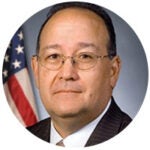
There wasn’t much to see in Orlando when FTU opened. You probably didn’t know the university existed unless you were a student or an instructor.
Ann Kujawa
Wife of longtime Geology Professor Frank Kujawa:
Oh yes, FTU. Frank and I were married in the Baltimore area on July 5, 1969, before coming down for his final interview. On July 16, we sat on top of the engineering building and watched the Apollo 11 launch. Our first men were headed to the moon. To see it so clearly, that was a huge surprise for Frank and me.
Lugo: Our family moved to Merritt Island in the 1960s. Dad worked for General Electric to support the space program. Everyone on the Space Coast had either transferred from up north or been recruited from big-name schools — Texas, Alabama, Virginia. I didn’t know anything about FTU until my high school English teacher sent me to compete in a speech contest on campus in 1973. It was mostly cow pastures, but the name FTU made me think about technology and the future.
Kujawa: There was a dirt road, a library and a science building. That’s pretty much it. But you could sense it was the beginning of something big.
Lugo: I wanted to work at NASA, so after high school I enrolled at the University of Florida. I transferred to FTU after one semester. One of my first professors, Ben Patz, worked at KSC. He knew how to apply concepts to real situations. That made the education at FTU unique.
Marcie (Swilley) Washington ’83
First African American woman to graduate from ���ֱ��’s engineering program, NASA engineer for 33 years:
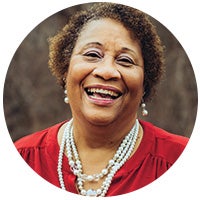
During my freshman orientation, an engineering advisor told parents, “Don’t be upset if your child drops out of this program because 50% of them will change majors.” They challenged students so we would be prepared to work anywhere, including NASA. You had this proximity to Cape Canaveral and this wonderful exchange of knowledge, but you still had to drive down a two-lane road through the forest to find it.
Lugo: We’d park where Addition [Financial] Arena is now. It was all sand. Sometimes you’d come back to your car and see the tires sunk up to the axles. But if you earned an engineering degree from ���ֱ��, or FTU, you could hold your own with anyone pursuing a career in the space industry.
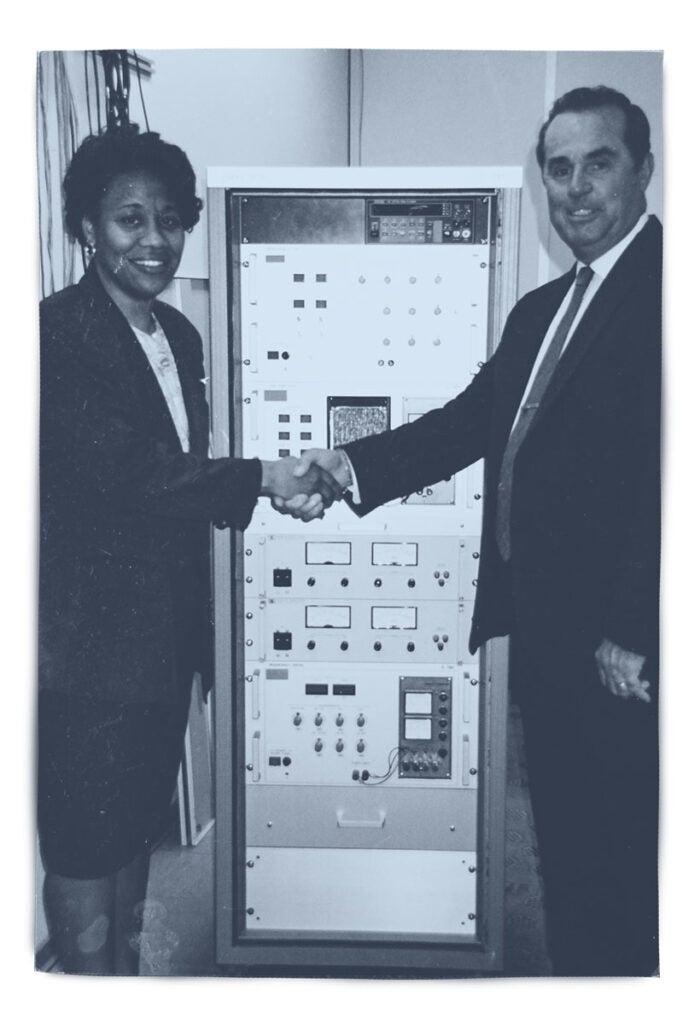
Marcie (Swilley) Washington ’83 with a NASA employee.
In December 1978, Florida Governor Reubin Askew signed legislation to change the school’s name to the ���ֱ��.
Washington: After high school I planned to attend FTU, but when I arrived for my freshman year the name had changed to ���ֱ��.
Lugo: I led a protest on campus against the name change. The president, Trevor Colbourn, heard about it and called me into his office. I thought, “This is not good.” My point was that I’d come to FTU as a gateway to NASA, and that the name made you think of advanced technology, like MIT. But President Colbourn had great vision. He told me the name FTU disenfranchised anyone who was not an engineering student. I said, “OK, I get that, but …”
Kujawa: [My husband] said he’d never seen a proposal pass through the state legislature as fast as the name change to ���ֱ��.
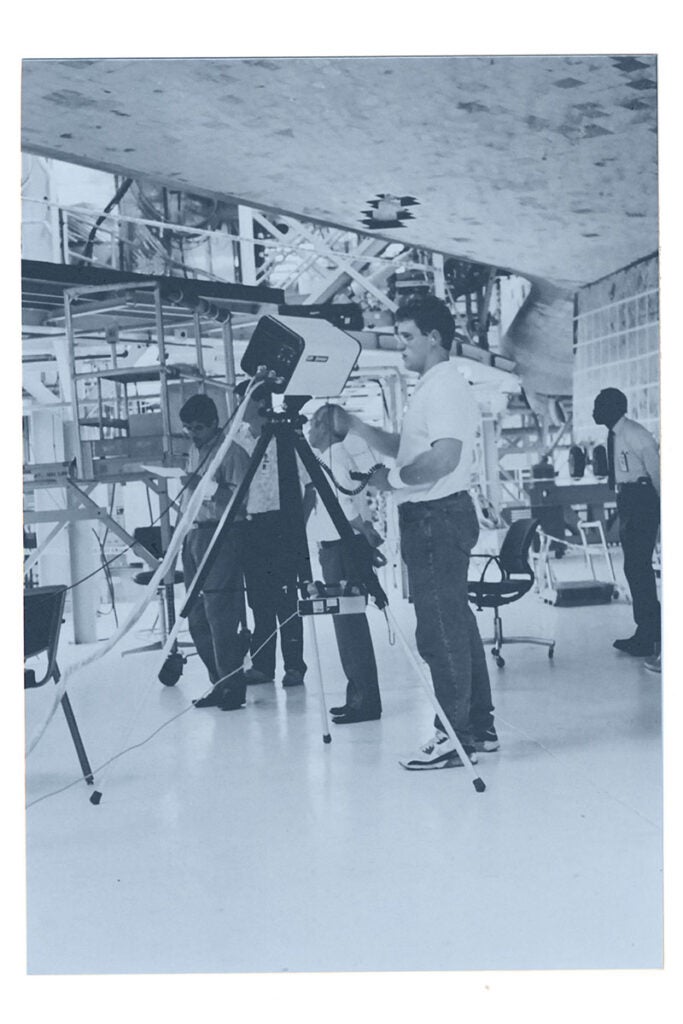
Faisal Moslehy (left) working with other scientists in the Space Shuttle landing facility in 1993.
When NASA transitioned its focus to the space shuttle program, ���ֱ�� was positioned how it had been from the beginning — logistically and academically — to help make it happen.
Lugo: By [the time we became ���ֱ�� in 1978], I’d been working in a co-op program at KSC for several years. Where else can a college freshman get that kind of experience — doing real work with the people who lead the country’s most important space program?
Washington: A recruiter from NASA came to ���ֱ�� before I graduated. I hadn’t thought about a career in the space industry. But NASA embodied the spirit of space exploration: Don’t ever tell us there’s something we can’t do. That fit my personality.
Lugo: When I went to work full time at KSC and began recruiting talent, you could see things shifting. For years, NASA and its partners hired people from outside the area to fill the talent pipeline. But by the early ’80s, I’d say ���ֱ�� graduates comprised at least 30% of the workforce. They brought youth and knowledge from experienced professors, yet the university was still small — and had a lot of dirt parking lots.
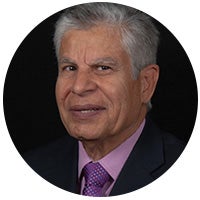
Faissal Moslehy
Professor emeritus, mechanical and aerospace engineering:
People asked me why I came to ���ֱ�� in 1980. I’d studied and worked in Egypt, Germany, Alabama and South Carolina. But you could sense a freedom at this young university to conduct new and meaningful research. We could help advance the space program. Also, I was newly married, and my wife did not want to live in cold weather.
Washington: As a new student, you might not be aware of the “Space University” moniker, but [back] then you’d go to the Student Union and watch a rocket launch at the cape — not on TV, but in real life. You knew you were somewhere special.
Moslehy: NASA never looked at ���ֱ�� as one of its traditional contractors. We’ve always had the proximity to the Space Coast and research capabilities. When the government cut NASA’s budgets, we could secure funding from other partners. We once proposed to save NASA money by researching nondestructive testing methods so they wouldn’t have to destroy rocket engines and shuttle tiles.
Lugo: Back then it was common for NASA to blow up expensive things as part of the test processes. It became too costly.
Moslehy: We invited leaders from KSC to drive over to our labs in the Engineering I building and see our lasers, digital processing, and optics and photonics equipment. They were impressed with all of it, but at the heart of our research they saw students.
Tim Kotnour
Lockheed Martin St. Laurent Professor:
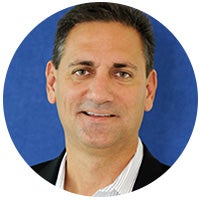
Leaders in the space industry have thanked us for years that when they hire ���ֱ�� graduates, those graduates hit the ground running from day one because of their hands-on, real-world learning.
Moslehy: One day I was working underneath an orbiter at KSC. The NASA engineers around the cockpit asked if I wanted to come up and look inside. I said, “Are you serious?” So, I put on a bunny suit and took off my wedding ring. A minute later, I’m sitting in the pilot’s seat of the space shuttle. How many instructors in the country can bring that kind of experience to their students and show them that their dreams are literally within reach?
Washington: If it weren’t for my experiences at ���ֱ��, I doubt I would have worked for the world’s best space agency for 33 years.
Moslehy: There are a lot of reasons why ���ֱ�� is the No. 1 supplier of aerospace defense talent. I had a student, Cooper Snapp ’06MS, who was already a NASA engineer. However, he knew a master’s degree from ���ֱ�� would help him advance. Today he’s a manager at Johnson Space Center. Stories like that are not unusual.
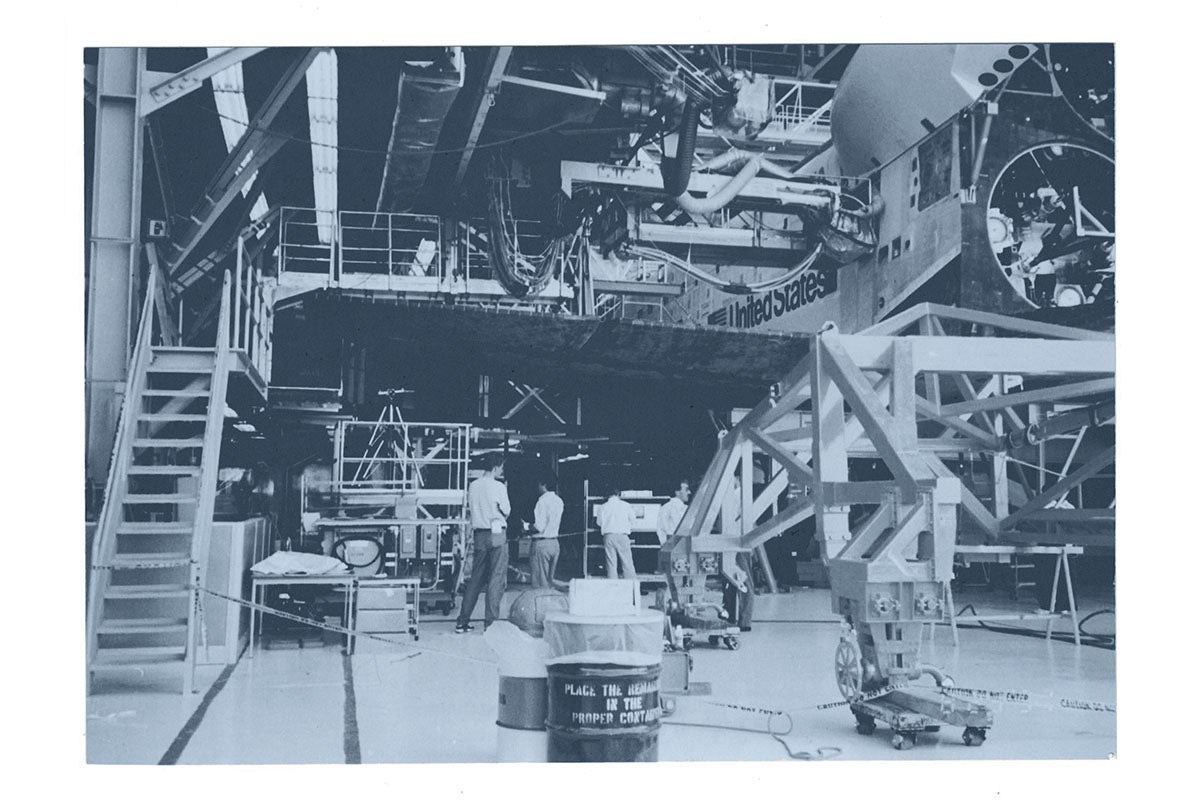
Professor Emeritus Faisal Mosley (second from left) conducting non-contact laser testing of the tiles bond condition underneath the Space Shuttle orbiter wing in 1993.
After finishing his Ph.D. at Virginia Tech in 1995, Kotnour interviewed for a teaching position at ���ֱ��. This would lead him into the kind of career he did not anticipate.
Kotnour: A ���ֱ�� professor, Jim Ragusa, showed me around campus during my interview. I thought it was interesting that he’d retired from NASA and taught at ���ֱ��. That connection attracted me to the job at ���ֱ��, but I had no idea where it was about to lead me.
Lugo: When [U.S. Astronaut Hall of Fame inductee] Roy Bridges became the director of KSC, he emphasized the value of relationships with ���ֱ��. He thought it could add to the space program despite budget constraints.
Kotnour: On my first official day at ���ֱ�� [in 1995], an administrator took me to my office and said, “Here you go, but in two weeks you’re going to KSC to teach NASA engineers as part of our accelerated master’s program.” I’m 27 years old. I just got here. I’m thinking, “What am I going to teach the highest-ranking people in the space program about project management? How do I give them grades?”
Wes Mosedale ’07MS
Senior test director at KSC:
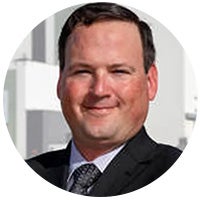
���ֱ�� professors would come out to KSC, which allowed us as full-time NASA employees to earn graduate degrees without leaving the immersive space environment.
Kotnour: One day I left home five hours early because I knew traffic would be bad for a shuttle launch. After they launched the shuttle, my KSC students walked over to a trailer and saw me waiting for them. One guy said, “We thought you’d cancel class today.” I said, “I wouldn’t miss the launch or the class.” When they saw how much I cared, it set the tone for the next 27 years.
Mosedale: I’m using [Kotnour’s] lessons to help us plan for the next Artemis missions.
Kotnour: As professors, we can bring everything we learn from NASA back to the classroom, and then our students can take those lessons into their careers. It creates a cycle to help keep the space program moving forward.
While ���ֱ�� grew into one of the biggest schools in the country, it also began to plant a new extension of its roots: the science of space. Humberto Campins came on board in 2002 as a world-renowned space researcher and provost research professor. He would begin to help complete the picture of a true Space University.
Humberto Campins
Pegasus Professor, physics:

I give the credit to the late physics faculty [member], Nadine Barlow. She convinced the administration of the need for an astronomy group. ���ֱ��’s physics chair, Brian Tonner, offered me a position, but I was happy at the University of Arizona. We had the No. 1 planetary science program in the world there. But when Brian came to me a third time, I knew ���ֱ�� was serious and I reluctantly left the mecca of planetary science for the potential I saw here.
Lugo: The engineering side helps get us into space. But science is what we do once we’re out there. Humberto knew ���ֱ�� needed a credible space science program to keep up with the changing industry.
�䲹���辱�Բ�:��Honestly, there were times when I questioned my decision, but everything changed when I was given the opportunity to increase faculty and hire people smarter than me. We hired Alan Stern after he stepped down as the associate administrator for space science at NASA headquarters in Washington, D.C. He was once named by Time magazine as one of the 100 people transforming the world. We brought Alan in to find a leader for our Florida Space Institute. Turns out, he hired this amazing guy [in 2013] who worked at NASA’s Glenn Research Center: Ray Lugo.
Lugo: Stern knew I was also a ���ֱ�� graduate — FTU, actually. I’m no scientist, but experts told me that for ���ֱ�� to take the next step, we needed an observatory. I thought, “OK, let’s go after the biggest one.”
Campins: Oh yes, Arecibo [Observatory in Puerto Rico]. That observatory was the world’s foremost facility for planetary radar and radioastronomy. The first map of the surface of Venus came from Arecibo. When Ray said he wanted to go for it, all I could say was, “You are very courageous.”
Lugo: I wrote a 500-page proposal over several months. Most people thought it was a long shot.
Campins: When Ray’s proposal won, I couldn’t believe it. [As of April 2018] we’d be managing Arecibo and collaborating with international partners. It took ���ֱ�� to another level.
Lugo: I’d been among the first decade of students at a university people called SpaceU. Bringing it the world’s most powerful radar 35 years later might be my biggest accomplishment. I was eating breakfast in San Juan, Puerto Rico, when it collapsed [December 1, 2020].
Campins: Hard as that was, the positives far outweigh anything else. The world-class scientists from the observatory are still on our team. We added them to people like Pegasus Professors Daniel Britt, who operated the first Mars rover; Josh Colwell, who leads our Center for Microgravity Research; Joseph Harrington, who studies extrasolar planets; and (Professor) Yan Fernandez, a renowned researcher of comets and asteroids; and many others. Recently, NASA awarded two ���ֱ�� professors, Kerri Donaldson Hanna and Adrienne Dove, a $35 million contract to lead a mission called Lunar-VISE to study a part of the moon that’s never been visited. We now have more than a dozen ongoing moon-related projects, including the Exolith Lab. … I could go on and on about why coming to ���ֱ�� turned out to be the best professional decision of my career. We’ve grown from one astronomer at ���ֱ�� to having one of the top five planetary sciences groups in the country. Where we are is much bigger than I ever expected.
In August, Kotnour received one of NASA’s highest honors, the Outstanding Public Leadership Medal. It is his fourth significant award from the space agency where he arrived 28 years ago as a nervous ���ֱ�� professor.
Kotnour: Everything I’ve done over there ties back to ���ֱ��. At the medal ceremony, all these high-ranking NASA people, including Deputy Director Kelvin Manning ’02MS, were saying, “He was my professor at ���ֱ��.” That’s my identity.
Moslehy: Considering the age of ���ֱ��, the growth has been exponential. We have Medical City, CREOL, Research Park, the Rosen College of Hospitality [Management], a football stadium. But the focus on space has been here all along.
Lugo: At the beginning, ���ֱ�� was sending talent to NASA and its partners. Look where the road out there leads now: SpaceX, Blue Origin, Redwire, Space Tango — it’s a long list. The university has a presence with all of them.
Kotnour: Whenever I call my dad and he asks, “What did you do today?” I can share the work I’m doing for the space program. That moment of pride never gets old.
Kujawa: We knew we were part of something special when we watched that Apollo launch from one of the only buildings on campus. The message has always been: Don’t accept mediocrity. Keep innovating. Go farther.
Kotnour: Every so often I ask a driver to take me to meetings at NASA so I can prepare. One time I left a letter for her. It said, “What you’re doing is significant. You allow me to be ready to meet with leaders who are sending rockets and humans into space.”
Moslehy: The university has had a bold motto from the time it opened: Reach for the Stars. The moon was the first goal. But space is never-ending. You cannot stop learning. You cannot stop reaching. Because there are so many more stars to reach.
















